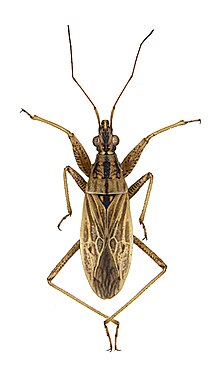Red-brown sickle bug
| Red-brown sickle bug | ||||||||||||
|---|---|---|---|---|---|---|---|---|---|---|---|---|

Red-brown sickle bug ( Nabis rugosus ) |
||||||||||||
| Systematics | ||||||||||||
|
||||||||||||
| Scientific name | ||||||||||||
| Nabis rugosus | ||||||||||||
| ( Linnaeus , 1758) |
The red-brown sickle bug ( Nabis rugosus ) is a bug from the sickle bug family (Nabidae).
features
The bugs reach a body length of 6.5 to 7.5 millimeters. They are yellow-brown in color and have pale forewings. The animals are almost always brachypter, so have reduced wings that reach the end of the abdomen or just before it. Only rarely do macroptere (fully winged) animals appear, which can then be confused with Nabis ferus and Nabis pseudoferus . The pronotum of the animals has a width to length ratio of 1.6: 1.5. The second part of the antennae is larger than the maximum width of the pronotum, whereby one can distinguish the species of Nabis ericetorum and Nabis brevis . The latter species also has, in addition to the dark points and lines that also occur in the red-brown sickle bug, dark areas on the thighs ( femora ) of the front legs. However, the species is generally difficult to distinguish from the other similar Nabis species and can only be determined with certainty by examining the male genitals. The nymphs are dark brown and often have a light and red stripe pattern.
Occurrence and habitat
The species is distributed in Europe from the northern edge of the Mediterranean to southern Scandinavia. Further east, the distribution extends to Central Asia and Siberia. The species is widespread in Central Europe and occurs in the lowlands as well as in the low mountain ranges and in the Alps up to about 1500 meters above sea level. It is Central Europe's most common type of sickle bug. As with the other species of the genus, many different habitats are populated; from open and dry, to shady and damp. However, the species prefers to colonize moderately humid, partially shaded places with dominant grass cover. Adjacent woody vegetation is obviously important for the species.
Way of life
The red-brown sickle bug hunts on the ground and also in the higher herb layer, only rarely in the shrub layer. The adults overwinter in the dry litter , in grass clusters, under moss cushions and the like. The females lay their eggs in blades of grass from May. The nymphs that hatch from the beginning of June develop over the summer and molt into adults from the beginning of August. The adults can be found year-round, although only one generation is trained each year. Mating takes place in September and October, as well as in spring, but fertile eggs only develop in spring.
supporting documents
Individual evidence
- ↑ Nabis rugosus. British Bugs, accessed November 21, 2013 .
- ↑ Red-brown sickle bug - Nabis rugosus (LINNAEUS, 1758). www.natur-in-nrw.de, accessed on November 21, 2013 .
- ↑ a b Ekkehard Wachmann , Albert Melber, Jürgen Deckert: Bugs. Volume 1: Cimicomorpha: Dipsocoromorpha, Nepomorpha, Gerromorpha, Leptopodomorpha, Cimicomorpha (part 1) (= The animal world of Germany and the adjacent sea parts according to their characteristics and according to their way of life . 77th part). Goecke & Evers, Keltern 2006, ISBN 3-931374-49-1 , p. 180 .
literature
- Ekkehard Wachmann , Albert Melber, Jürgen Deckert: Bugs. Volume 1: Cimicomorpha: Dipsocoromorpha, Nepomorpha, Gerromorpha, Leptopodomorpha, Cimicomorpha (part 1) (= The animal world of Germany and the adjacent sea parts according to their characteristics and according to their way of life . 77th part). Goecke & Evers, Keltern 2006, ISBN 3-931374-49-1 .
